Incontinence Advice
Urinary incontinence in the elderly: Effective care methods to treat incontinence

Is incontinence just a fact of growing older? Discover the truth about this sensitive issue and how it can be effectively managed.
Urinary incontinence in the elderly is not an inevitable part of ageing. In fact, incontinence can occur at any age, from children experiencing giggle incontinence to younger and middle-aged adults. While the body’s natural ageing process can contribute to incontinence, this does not mean it is unavoidable. In this article, we will examine the causes, impacts and management strategies for incontinence in the elderly. Whether due to ageing muscles, medical conditions, or lifestyle factors, understanding and addressing urinary incontinence can significantly improve quality of life.
Key points
- Discover the common and not-so-common causes of urinary incontinence in the elderly.
- Learn about different types of incontinence and how they affect daily life.
Explore lifestyle tips that can help improve symptoms.
Understand when and how to seek medical advice.
Urinary incontinence in the elderly
Understanding incontinence in the elderly
There are several ways in which elderly people can be affected by incontinence.
Age
As individuals age, physical changes in the bladder and the urinary tract can increase the likelihood of incontinence. Muscles around the bladder lose tone and strength (the pelvic floor), which can lead to incomplete bladder emptying or a weakened sphincter, thereby reducing control over the flow of urine. Additionally, the bladder's capacity often decreases with age, reducing the ability to hold urine before it becomes imperative to find a toilet.
Medical conditions
Several health issues can impact urinary incontinence in the elderly. Urinary tract infections, which can have a huge impact on elderly adults, can irritate the bladder, causing urgent and frequent urination.
Chronic conditions such as diabetes, stroke, and neurological disorders like Parkinson's disease also contribute significantly to incontinence by impairing nerve signals or muscle function. Additionally, arthritis or limited mobility can make it harder to reach the bathroom in time, leading to accidents. These health issues often interact, compounding the challenges of managing incontinence and emphasising the importance of tailored care and support.
Medications
Certain medications can contribute to incontinence by affecting the bladder’s function or altering the body’s fluid balance. Diuretics, often prescribed for conditions like high blood pressure or heart failure, increase urine production, which can lead to more frequent urges to urinate and sometimes leakage.
Other medications, such as sedatives, may relax the muscles around the bladder or interfere with the brain's signals to the bladder, leading to a reduced ability to control urination. Some medications may cause slower reaction times, making it challenging to reach a toilet on time.
Always consult a healthcare provider if incontinence occurs after starting a new medication, as adjustments or alternative treatments may be needed.
Mobility
Physical mobility limitations due to conditions like arthritis or aftermaths when recovering from surgery can also hinder timely toilet access, leading to incidents of incontinence. This is why it is important to have a ‘Just Can’t Wait’ card in social situations so that elderly adults can access a public toilet hastily.
Impact on quality of life
Incontinence can profoundly affect an elderly person's quality of life and emotional well-being. The condition is often hidden due to embarrassment, which can lead to isolation, anxiety and depression. Incontinence can also disrupt daily routines, making simple tasks like attending events or travelling stressful, as individuals may feel tied to the proximity of a bathroom. Sleep disturbances are common, as frequent nighttime trips to the bathroom interfere with rest, contributing to fatigue and further reducing quality of life.
There can also be a misconception that incontinence is an inevitable part of ageing, but effective treatments are available, and discussing bladder issues with a healthcare professional is key to managing the condition effectively and regaining control. Helping the elderly person feel at ease is essential, and if accidents do occur, sometimes making light of the situation can avoid awkwardness and tension - read more in our advice for carers guide.

Types of urinary incontinence
Understanding the types of urinary incontinence is essential, as different types require different approaches to treatment. Individuals may experience more than one type at the same time, known as mixed incontinence.
Stress incontinence: This type of incontinence occurs when physical pressure is exerted on the bladder, leading to urine leakage. Activities such as coughing, sneezing, or lifting heavy objects can trigger this. Stress incontinence in the elderly is often due to weakened pelvic floor muscles, which are less able to support the bladder as they age. This form is particularly common among older women and some men following prostate surgery.
Urge incontinence: This type of incontinence is characterised by a sudden, intense need to urinate, often resulting in leakage before reaching a toilet. This may be associated with overactive bladder syndrome, where involuntary bladder contractions cause frequent and sudden urges to urinate. This type of incontinence can be challenging for elderly people, as they may not be able to reach a toilet quickly due to reduced mobility, and rushing can increase the risk of falls.
Overflow incontinence: Overflow incontinence occurs when the bladder cannot empty completely, leading to frequent, minor leakage. This type may be due to blockages, nerve damage, or conditions such as diabetes. Bladder incontinence in elderly individuals can be complicated by other health issues, including recurrent urinary tract infections and conditions that prevent the bladder from fully emptying.
Functional incontinence: This is where other conditions make it difficult to get to a toilet in time, such as issues with mobility or a lack of awareness about needing to get to a toilet.
Total incontinence: In cases of total incontinence, individuals are unable to hold urine at all, leading to constant leakage. This type often results from severe neurological conditions or structural issues within the urinary tract. Total incontinence is relatively rare but can have a significant impact on daily life, requiring continuous management strategies.
Additionally, nocturia, the need to urinate multiple times during the night, is common among older people. If nocturia occurs more than twice per night or disrupts sleep to the point of causing fatigue, it’s advisable to consult a healthcare provider for potential treatments or lifestyle adjustments, and to use incontinence bed protection at night to protect both the individual and the bedding.

Supporting loved ones with incontinence
Supporting someone with incontinence requires understanding, compassion, and practical strategies to help manage daily challenges and maintain a good quality of life. Whether you are a professional carer, or looking after an elderly family member, you can follow these expert tips to ensure that you give elderly people with incontinence the utmost care and reassurance.
Planning for mobility
When planning social outings, identifying potential toilet stops along the route can ease anxiety, allowing for a more enjoyable and stress-free experience. This planning is especially crucial during longer trips to ensure that the elderly can manage incontinence discreetly and comfortably.
Skincare
The risk of skin irritation increases with incontinence because of the challenge of maintaining dry and clean skin. We advise washing with mild soap and water, or a non-rinse cleanser such as MoliCare skin cleansing foam for intimate area avoiding harsh chemicals and fragrances that can further irritate the skin. It’s also important to pat the skin dry rather than rubbing, to minimise irritation. Our range of incontinence skin care products also ensures that those experiencing incontinence can keep their skin protected against potential infections and further irritation - choose MoliCare skin barrier cream today.
Changing pads
The use of incontinence products is a standard method to manage incontinence in older people, and regular changes are critical. Changing these products soon after they become soiled maintains hygiene and reduces the risk of infections and odours that can affect comfort and confidence. You can now opt for washable incontinence underwear, which is designed to withstand up to fifty washes for both practicality and sustainability.
Discover how to dispose of soiled incontinence pads correctly.

Lifestyle tips
Attire: Choosing the right clothing can significantly impact managing incontinence with dignity. Garments with elastic waists, zippers, or Velcro make it easier to dress and undress quickly, particularly when urgent toilet visits arise. This small adjustment can lead to greater confidence and less stress when out in public.
Fluids: It might seem counterintuitive, but reducing fluid intake to manage urinary incontinence is not advisable. Regular hydration is essential for bladder health, as stagnant urine can irritate the urinary system and encourage infections. Experts recommend bladder-friendly drinks such as water, diluted fruit juices, and caffeine-free beverages instead of diuretics such as caffeinated or alcoholic drinks, which increase urine production and can irritate the bladder.
Exercise: Exercising while incontinent is both possible and beneficial, especially when focusing on the pelvic floor muscles. Low-impact activities, such as walking or swimming, can support overall health without adding any extra strain. Exercises should be tailored to each individual’s mobility, making exercising achievable and enjoyable. Daily routines can be structured that sync with the individual’s natural body cycles, optimising toilet visits before activities to reduce accidents.
Nighttime assistance: For many elderly people, nighttime can bring anxiety due to increased incontinence issues - also known as incontinence anxiety. Live-in carers can assist with safe trips to the toilet or manage portable commodes, ensuring comfort and reducing the risk of falls during the night.
Supporting independence
Preserving dignity and independence is crucial for quality of life. This means offering the right tools and guidance, empowering elderly people to make informed choices about their care and daily routines, and encouraging them to stay as active and engaged as their condition allows. Whether they are facing dementia or other impairments, providing reassurance, comfort and a calm presence will allow them to feel secure and valued.
Choose MoliCare®to support the elderly with incontinence care
Our range of incontinence products – from high-absorbency incontinence pants to skin cleansing foam – complements the dedicated efforts of carers. Designed to offer protection, comfort and discretion, our products add a dependable layer of reliability to incontinence management. With MoliCare®, carers can offer enhanced confidence and ease, making everyday life more comfortable and dignified for elderly people.
FAQs
What types of assistive technology or devices are available for incontinence management?
Devices such as urinals and commode chairs can provide convenient alternatives to night time toilet trips and assist those with mobility issues. Bed protectors can add an extra layer of protection, allowing for a more restful sleep, maintaining hygiene and reducing laundry loads. There are washable and disposable options. Catheters and urine collection bags can be used where bladder control is not possible.
Is it possible to regain full continence?
The likelihood of full recovery depends on the underlying cause, the individual’s overall health, and the type of incontinence. With appropriate treatment, many people experience significant improvement, and some may achieve complete control.
Can stress or psychological factors impact incontinence?
Yes, stress and anxiety can exacerbate incontinence symptoms. Addressing mental health and incorporating stress-relief practices, such as mindfulness or relaxation techniques, can be beneficial.
Bladder & Bowels. (2020) FREE Just Can’t Wait Toilet Card. [online] Available at: https://www.bladderandbowel.org/free-just-cant-wait-card/ [accessed 05/11/2024]
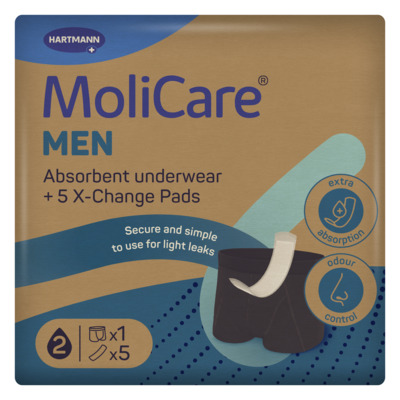 MoliCare® MEN Absorbent underwear + 5 X-Change Pads
<h3><strong>Men's washable incontinence pants with an invisible pad for extra protection</strong></h3>
<p>Feel confidently fresh all day with MoliCare® MEN Absorbent underwear with X-Change Pads. <br />
A discreet, simple-to-use solution for very light bladder weakness. Thanks to a special hidden pocket inside the underwear, you can easily insert a MoliCare X-Change Pad for extra protection which stays securely in place and is invisible. Just look for the layer of extra fabric inside the underwear and slip the pad into it for increased absorbency and security.<br />
With 4 layers of protection and a special leakproof technique MoliCare® MEN Absorbent underwear with X-Change Pads is designed to keep you feeling confident and dry for up to 12 hours*. The X-Change Pad converts liquid into gel to reliably lock away up to 25 teaspoons (approx. 125 ml) of urine and neutralise odours.<br />
The men’s washable incontinence pants are comfortable to wear and have a masculine, timeless design.<br />
Indistinguishable from normal underwear, 83%** of men say the product is a convincing alternative to conventional disposable products. There’s no need to change your underpants throughout the day, simply replace the exchangeable absorbent core whenever you need.<br />
*Hours will vary depending on amount of urine and individual bladder habits.<br />
**Internal test at Paul Hartmann AG, 12/2023, Top 2 Box, n= 16 men, Germany </p>
MoliCare® MEN Absorbent underwear + 5 X-Change Pads
<h3><strong>Men's washable incontinence pants with an invisible pad for extra protection</strong></h3>
<p>Feel confidently fresh all day with MoliCare® MEN Absorbent underwear with X-Change Pads. <br />
A discreet, simple-to-use solution for very light bladder weakness. Thanks to a special hidden pocket inside the underwear, you can easily insert a MoliCare X-Change Pad for extra protection which stays securely in place and is invisible. Just look for the layer of extra fabric inside the underwear and slip the pad into it for increased absorbency and security.<br />
With 4 layers of protection and a special leakproof technique MoliCare® MEN Absorbent underwear with X-Change Pads is designed to keep you feeling confident and dry for up to 12 hours*. The X-Change Pad converts liquid into gel to reliably lock away up to 25 teaspoons (approx. 125 ml) of urine and neutralise odours.<br />
The men’s washable incontinence pants are comfortable to wear and have a masculine, timeless design.<br />
Indistinguishable from normal underwear, 83%** of men say the product is a convincing alternative to conventional disposable products. There’s no need to change your underpants throughout the day, simply replace the exchangeable absorbent core whenever you need.<br />
*Hours will vary depending on amount of urine and individual bladder habits.<br />
**Internal test at Paul Hartmann AG, 12/2023, Top 2 Box, n= 16 men, Germany </p>
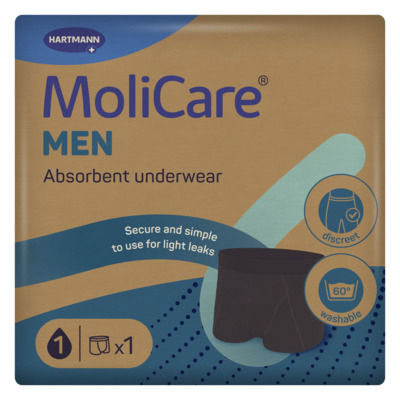 MoliCare® MEN Absorbent underwear
<h2><strong>Protective underwear for drips and dribbles in men</strong></h2>
<p>Get protection for men without the need for pads with MoliCare<sup>®</sup> Men Absorbent underwear. </p>
<p>Offering reliable leak protection, this washable men's underwear securely locks away urine thanks to its quick-dry technology. They look and feel exactly like your regular men’s boxers but with the subtle difference that they can hold up to 10 teaspoons of urine (50 ml). </p>
<p>Designed in Germany, MoliCare<sup>®</sup> Men underwear is dermatologically tested, free of harmful substances and Oeko-Tex 100 certified. Wash this men’s underpants for incontinence at 60° Celsius and use them again and again. </p>
<p><strong>Who is MoliCare<sup>®</sup> Men Absorbent underwear suitable for? </strong></p>
<p>MoliCare<sup>®</sup> Men underwear is for men who experience very light bladder weakness, resulting in small drops of spontaneous urine loss. The invisible men's bladder weakness pants are washable even at 60° Celsius, eliminating odour-causing bacteria.</p>
<p>Designed to look and feel like your normal underwear, they’re easy to put on and off.</p>
<h2><strong>Reusable and convenient solution for drips and dribbles</strong></h2>
<p>Don’t worry about dribbling after urination anymore. MoliCare<sup>®</sup> Men Absorbent underwear are discreet, washable men’s incontinence briefs offering a sustainable, comfortable and skin-friendly alternative to other hygiene products.</p>
<p>Indistinguishable from normal underwear, 87%* of men say the product is a convincing alternative to conventional disposable products.</p>
<p>Free of harmful substances, washable at 60° Celsius and suitable for tumble drying, MoliCare<sup>®</sup> Men Absorbent underwear combines leakproof protection and sustainability with a masculine, yet invisible design so no one will ever know you’re wearing washable incontinence pants. </p>
<p>* Internal test at Paul Hartmann AG, 12/2023, Top 2 Box, n= 16 men, Germany</p>
<p><strong>Caring for your reusable MoliCare<sup>®</sup> Men Absorbent underwear: a step-by-step guide</strong></p>
<ul>
<li>Wash before first use</li>
<li>Rinse out with cold water after use</li>
<li>Use a mild detergent to ensure underwear maintains its functionality. Do not use fabric softeners</li>
<li>Hygienically wash your MoliCare®Absorbent underwear at 60 °C</li>
<li>After washing you can tumble dry your underwear on a low heat</li>
<li>Following these steps will help your underwear stay fresh, clean and ready to wear</li>
</ul>
MoliCare® MEN Absorbent underwear
<h2><strong>Protective underwear for drips and dribbles in men</strong></h2>
<p>Get protection for men without the need for pads with MoliCare<sup>®</sup> Men Absorbent underwear. </p>
<p>Offering reliable leak protection, this washable men's underwear securely locks away urine thanks to its quick-dry technology. They look and feel exactly like your regular men’s boxers but with the subtle difference that they can hold up to 10 teaspoons of urine (50 ml). </p>
<p>Designed in Germany, MoliCare<sup>®</sup> Men underwear is dermatologically tested, free of harmful substances and Oeko-Tex 100 certified. Wash this men’s underpants for incontinence at 60° Celsius and use them again and again. </p>
<p><strong>Who is MoliCare<sup>®</sup> Men Absorbent underwear suitable for? </strong></p>
<p>MoliCare<sup>®</sup> Men underwear is for men who experience very light bladder weakness, resulting in small drops of spontaneous urine loss. The invisible men's bladder weakness pants are washable even at 60° Celsius, eliminating odour-causing bacteria.</p>
<p>Designed to look and feel like your normal underwear, they’re easy to put on and off.</p>
<h2><strong>Reusable and convenient solution for drips and dribbles</strong></h2>
<p>Don’t worry about dribbling after urination anymore. MoliCare<sup>®</sup> Men Absorbent underwear are discreet, washable men’s incontinence briefs offering a sustainable, comfortable and skin-friendly alternative to other hygiene products.</p>
<p>Indistinguishable from normal underwear, 87%* of men say the product is a convincing alternative to conventional disposable products.</p>
<p>Free of harmful substances, washable at 60° Celsius and suitable for tumble drying, MoliCare<sup>®</sup> Men Absorbent underwear combines leakproof protection and sustainability with a masculine, yet invisible design so no one will ever know you’re wearing washable incontinence pants. </p>
<p>* Internal test at Paul Hartmann AG, 12/2023, Top 2 Box, n= 16 men, Germany</p>
<p><strong>Caring for your reusable MoliCare<sup>®</sup> Men Absorbent underwear: a step-by-step guide</strong></p>
<ul>
<li>Wash before first use</li>
<li>Rinse out with cold water after use</li>
<li>Use a mild detergent to ensure underwear maintains its functionality. Do not use fabric softeners</li>
<li>Hygienically wash your MoliCare®Absorbent underwear at 60 °C</li>
<li>After washing you can tumble dry your underwear on a low heat</li>
<li>Following these steps will help your underwear stay fresh, clean and ready to wear</li>
</ul>
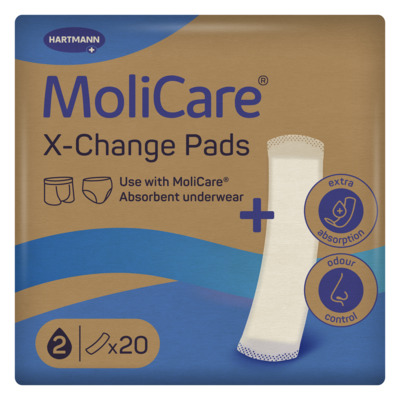 MoliCare® X-Change Pads
<h3><strong>Invisible underwear pads providing extra protection for MoliCare® Absorbent underwear</strong></h3>
<p>Enjoy that dry feeling for up to 12 hours* with MoliCare® X-Change Pads. <br />
Designed to add increased protection to MoliCare® Absorbent underwear, MoliCare® X-Change pads have a highly absorbent core that turns liquid into gel and neutralises unpleasant odours. The pad can hold up to 20 teaspoons (approx. 100 ml) of urine.<br />
Invisible due to the integrated pocket in MoliCare® Absorbent underwear, the pad stays in place and gives you the security of extra leakproof protection when you need it most. Just look for the extra layer of fabric inside the underwear and slip the pad into the pocket for increased absorbency and security against light bladder weakness. This unique concept is patented by HARTMANN.<br />
MoliCare® X-Change incontinence pads for underwear are easy to change and dispose of in public washrooms. Made to reduce disposable waste by 78 % compared to other incontinence products, they are free of silver chloride and other biocides that can have a negative impact on the intimate flora and environment.<br />
*Hours will vary depending on amount of urine and individual bladder habits.</p>
MoliCare® X-Change Pads
<h3><strong>Invisible underwear pads providing extra protection for MoliCare® Absorbent underwear</strong></h3>
<p>Enjoy that dry feeling for up to 12 hours* with MoliCare® X-Change Pads. <br />
Designed to add increased protection to MoliCare® Absorbent underwear, MoliCare® X-Change pads have a highly absorbent core that turns liquid into gel and neutralises unpleasant odours. The pad can hold up to 20 teaspoons (approx. 100 ml) of urine.<br />
Invisible due to the integrated pocket in MoliCare® Absorbent underwear, the pad stays in place and gives you the security of extra leakproof protection when you need it most. Just look for the extra layer of fabric inside the underwear and slip the pad into the pocket for increased absorbency and security against light bladder weakness. This unique concept is patented by HARTMANN.<br />
MoliCare® X-Change incontinence pads for underwear are easy to change and dispose of in public washrooms. Made to reduce disposable waste by 78 % compared to other incontinence products, they are free of silver chloride and other biocides that can have a negative impact on the intimate flora and environment.<br />
*Hours will vary depending on amount of urine and individual bladder habits.</p>
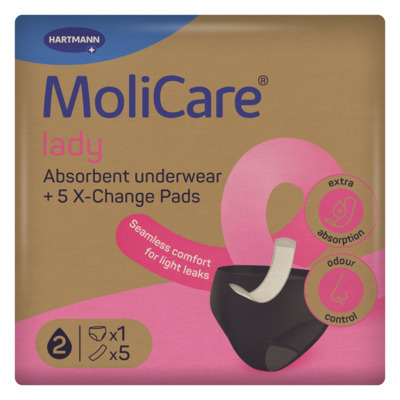 MoliCare® Lady Washable & Absorbent Underwear X-Change Pads
<h2>Why Choose MoliCare<sup>®</sup> washable bladder weakness underwear?</h2>
<p> </p>
<ul>
<li>Unique washable incontinence pants for ladies with a hidden pocket to insert MoliCare<sup>®</sup> X-Change Pads for extra protection</li>
<li>Versatile daily hygiene product for very light bladder weakness</li>
<li>In combination with the exchangeable X-Change Pads, these washable incontinence pants safely lock away up to 30 teaspoons (approx. 149 ml) of urine for a secure, dry feeling</li>
<li>Leakproof pant with a seamless and invisible design for maximum discretion</li>
<li>MoliCare<sup>®</sup> X-Change Pads provide reliable odour control and are easily inserted into the pants and changed as required</li>
<li>Hygienically wash the incontinence pants at 60°C, without the X-Change Pad</li>
<li>78% less plastic waste compared to conventional disposable incontinence products</li>
<li>Suitable for tumble drying</li>
<li>Free of silver chloride and other biocides that can negatively affect vaginal flora</li>
<li>Designed in Germany and made from soft, gentle-on-skin fabrics</li>
<li>This pack contains one pair of women's washable incontinence pants in Size M or Size L plus 5 X-Change-Pads</li>
<li>Designed in Germany and made from soft, gentle-on-skin fabrics</li>
<li>Medium size corresponds to EU size 40/42, or dress size 14-16</li>
</ul>
MoliCare® Lady Washable & Absorbent Underwear X-Change Pads
<h2>Why Choose MoliCare<sup>®</sup> washable bladder weakness underwear?</h2>
<p> </p>
<ul>
<li>Unique washable incontinence pants for ladies with a hidden pocket to insert MoliCare<sup>®</sup> X-Change Pads for extra protection</li>
<li>Versatile daily hygiene product for very light bladder weakness</li>
<li>In combination with the exchangeable X-Change Pads, these washable incontinence pants safely lock away up to 30 teaspoons (approx. 149 ml) of urine for a secure, dry feeling</li>
<li>Leakproof pant with a seamless and invisible design for maximum discretion</li>
<li>MoliCare<sup>®</sup> X-Change Pads provide reliable odour control and are easily inserted into the pants and changed as required</li>
<li>Hygienically wash the incontinence pants at 60°C, without the X-Change Pad</li>
<li>78% less plastic waste compared to conventional disposable incontinence products</li>
<li>Suitable for tumble drying</li>
<li>Free of silver chloride and other biocides that can negatively affect vaginal flora</li>
<li>Designed in Germany and made from soft, gentle-on-skin fabrics</li>
<li>This pack contains one pair of women's washable incontinence pants in Size M or Size L plus 5 X-Change-Pads</li>
<li>Designed in Germany and made from soft, gentle-on-skin fabrics</li>
<li>Medium size corresponds to EU size 40/42, or dress size 14-16</li>
</ul>
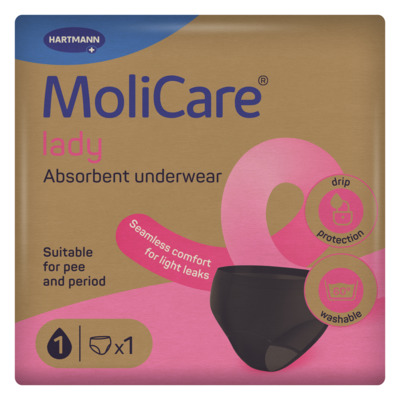 MoliCare® Lady Absorbent Underwear
<h2>Invisible and reliable pee and period underwear</h2>
<p>Whether you’re looking for washable period underwear or eco-friendly incontinence pants, MoliCare<sup>®</sup> Lady Absorbent Underwear is the product you’ve been searching for. </p>
<p>As comfortable as your normal underwear, this women’s absorbent underwear perfectly fits your body with its seamless design to ensure discreet and reliable leakproof protection for both periods and very light bladder weakness. </p>
<p>Free of silver chloride and other biocides, this period underwear does <strong>not </strong>harm your vaginal flora and has <strong>no </strong>negative impact on the environment.<br />
MoliCare<sup>®</sup> Lady Absorbent Underwear is dermatologically tested, Oeko-Tex 100 certified and can be washed and reused as often as normal underwear. Designed in Germany, these incontinence pants are machine washable at 60° Celsius and generate zero waste compared to conventional disposable incontinence products.</p>
<h2>Who is MoliCare<sup>®</sup> Lady Absorbent Underwear suitable for?</h2>
<p>With its feminine design, MoliCare<sup>®</sup> Lady Absorbent Underwear is for women experiencing very light bladder weakness, resulting in spontaneous loss of small urine trickles, and looking for an invisible and sustainable solution. Wash at 60° Celsius to elimiate odour-causing bacteria and wear like regular underwear. They can also be worn during your period.</p>
<h2>Washable period underwear for menstrual leaks</h2>
<p>Don’t worry about those little leaks anymore. MoliCare<sup>®</sup> Lady Absorbent Underwear is a discreet and absorbent washable period underwear offering a sustainable, comfortable, and skin-friendly alternative to other feminine hygiene products. </p>
<p>Free of harmful substances, washable at 60° Celsius and suitable for tumble drying. MoliCare<sup>®</sup> lady Absorbent underwear combines leakproof protection and sustainability with a modern and elegant, yet invisible design so no one will ever know you’re wearing reusable period underwear or washable incontinence pants.</p>
<p><strong>Caring for your reusable MoliCare<sup>®</sup> lady Absorbent underwear: a step-by-step guide</strong></p>
<ul>
<li>Wash at 60 °C before first use</li>
<li>Rinse out with cold water after wearing</li>
<li>Use a mild detergent to ensure underwear maintains its functionality. Do not use fabric softeners</li>
<li>Hygienically wash your MoliCare<sup>®</sup> Absorbent Underwear at 60 °C to eliminate odour-causing bacteria</li>
<li>Tumble dry your underwear on a low heat after washing</li>
<li>Following these steps will help your underwear stay fresh, clean, and ready to wear again. No waste compared to disposable pads: use, wash and reuse</li>
</ul>
MoliCare® Lady Absorbent Underwear
<h2>Invisible and reliable pee and period underwear</h2>
<p>Whether you’re looking for washable period underwear or eco-friendly incontinence pants, MoliCare<sup>®</sup> Lady Absorbent Underwear is the product you’ve been searching for. </p>
<p>As comfortable as your normal underwear, this women’s absorbent underwear perfectly fits your body with its seamless design to ensure discreet and reliable leakproof protection for both periods and very light bladder weakness. </p>
<p>Free of silver chloride and other biocides, this period underwear does <strong>not </strong>harm your vaginal flora and has <strong>no </strong>negative impact on the environment.<br />
MoliCare<sup>®</sup> Lady Absorbent Underwear is dermatologically tested, Oeko-Tex 100 certified and can be washed and reused as often as normal underwear. Designed in Germany, these incontinence pants are machine washable at 60° Celsius and generate zero waste compared to conventional disposable incontinence products.</p>
<h2>Who is MoliCare<sup>®</sup> Lady Absorbent Underwear suitable for?</h2>
<p>With its feminine design, MoliCare<sup>®</sup> Lady Absorbent Underwear is for women experiencing very light bladder weakness, resulting in spontaneous loss of small urine trickles, and looking for an invisible and sustainable solution. Wash at 60° Celsius to elimiate odour-causing bacteria and wear like regular underwear. They can also be worn during your period.</p>
<h2>Washable period underwear for menstrual leaks</h2>
<p>Don’t worry about those little leaks anymore. MoliCare<sup>®</sup> Lady Absorbent Underwear is a discreet and absorbent washable period underwear offering a sustainable, comfortable, and skin-friendly alternative to other feminine hygiene products. </p>
<p>Free of harmful substances, washable at 60° Celsius and suitable for tumble drying. MoliCare<sup>®</sup> lady Absorbent underwear combines leakproof protection and sustainability with a modern and elegant, yet invisible design so no one will ever know you’re wearing reusable period underwear or washable incontinence pants.</p>
<p><strong>Caring for your reusable MoliCare<sup>®</sup> lady Absorbent underwear: a step-by-step guide</strong></p>
<ul>
<li>Wash at 60 °C before first use</li>
<li>Rinse out with cold water after wearing</li>
<li>Use a mild detergent to ensure underwear maintains its functionality. Do not use fabric softeners</li>
<li>Hygienically wash your MoliCare<sup>®</sup> Absorbent Underwear at 60 °C to eliminate odour-causing bacteria</li>
<li>Tumble dry your underwear on a low heat after washing</li>
<li>Following these steps will help your underwear stay fresh, clean, and ready to wear again. No waste compared to disposable pads: use, wash and reuse</li>
</ul>
